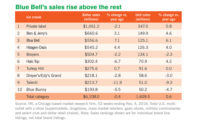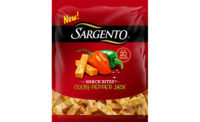
Mixed Bag
by Julie Cook Ramirez
Bouncing back from pricing woes, butter makers face competition from trans-fat-free spreads.
By nature, consumers are a
fickle lot. witness music fads that go from smash to crash; movie stars who
once ruled the box office, but suddenly find themselves unemployed; and
cuisine styles that appear to go from haute to not seemingly overnight.
When it comes to the world of dairy, no category has
felt the impact of the fickle consumer quite like butter and margarine.
From debates over which product is healthier — or less unhealthy, as
the case may be — to price fluctuations that routinely result in a
mass exodus from one subcategory to the other, the vast majority of
consumers don’t seem especially loyal one way or the other.
“There are consumers that will always eat butter
and there are consumers that will always eat margarine, but there’s
this huge group in the middle that is swayed by factors such as
price,” says Brenda Doke, associate product manager, Keller’s
Creamery LLP, Harleysville, Pa., a subsidiary of Kansas City, Mo.-based
Dairy Farmers of America. “When we see increases in price due to raw
materials increases in the commodity markets, then we see some consumers go
to margarine because it’s a lower-cost product.”
| TOP 10 INDIVIDUAL BUTTER BRANDS* | |||||
| $ Sales (In Millions) |
% Change vs. Year Ago |
Dollar Share |
Unit Sales (In Millions) |
% Change vs. Year Ago |
|
| Total Category | $1,240.7 | -6.4% | 100.0% | 450.7 | 0.2% |
| Private Label | 573.0 | -7.5 | 46.2 | 233.3 | 0.8 |
| Land O’Lakes | 355.1 | -6.8 | 28.6 | 110.9 | -0.8 |
| Challenge | 60.6 | -2.0 | 4.9 | 17.5 | 0.9 |
| Breakstone | 33.8 | -6.3 | 2.7 | 14.0 | -4.5 |
| Tillamook | 24.1 | -17.0 | 1.9 | 7.5 | -14.0 |
| Keller’s | 22.0 | 6.4 | 1.8 | 8.0 | 13.8 |
| Crystal Farms | 20.4 | -17.7 | 1.6 | 8.0 | -14.0 |
| Hotel Bar | 19.3 | 13.6 | 1.6 | 6.6 | 8.4 |
| Cabot | 17.8 | 10.1 | 1.4 | 6.2 | 26.3 |
| Horizon Organic | 12.1 | 22.2 | 1.0 | 2.2 | 15.8 |
| * Total sales in supermarkets, drug stores and mass merchandisers, excluding Wal-Mart, for the 52-week period ending June 18, 2006. SOURCE: Information Resources Inc. |
|||||
In regard to pricing, the past year has been a good
one for butter. After surpassing $2 per pound in 2004, butterfat prices
have fallen precipitously and have recently been hovering around $1.15 per
pound. That trend has enabled the category to rebound sales-wise from last
year when dollar sales of butter were up 21 percent, but unit sales were
down more than 6 percent, according to Chicago-based Information Resources
Inc. (IRI). During the 52-week period ending June 18, 2006, butter sales
fell 6.4 percent in dollars — reflecting the decrease in butterfat
price — but rose 0.2 percent in units throughout supermarkets,
drugstores and mass merchandisers, excluding Wal-Mart, according to IRI.
While butter’s fortunes were on the rise, the
margarine category didn’t fare so well — falling 4.5 percent in
dollars and 7.7 percent in units, according to IRI. Lower butter prices
certainly did their part in luring consumers away from margarine, but
there’s also no denying the impact of the new labeling requirements,
as well as all the media attention on the danger of trans-fatty acids,
present in most margarines.
Suddenly, consumers were all-too-aware of the health
hazards of eating margarine. As a result, a number of them switched over to
butter, or to the growing number of trans fat-free spreads which promised
them the best of both worlds — lowfat like margarine, but trans
fat-free like butter.
| TOP 10 INDIVIDUAL MARGARINE/SPREADS/ BUTTER BLEND BRANDS* | ||||||
| $ Sales (In Millions) |
% Change vs. Year Ago |
Dollar Share |
Unit Sales (In Millions) |
% Change vs. Year Ago |
||
| Total Category I Can’t Believe |
$1,185.3 | -4.5% | 100.0% | 792.2 | -7.7% | |
| It’s Not Butter | 233.5 | -5.5 | 19.7 | 123.6 | -6.5 | |
| Shedd’s Country Crock | 183.8 | -3.4 | 15.5 | 96.0 | -3.4 | |
| Private Label | 85.9 | -11.9 | 7.2 | 87.7 | -13.4 | |
| Parkay | 74.9 | -17.7 | 6.3 | 53.6 | -20.9 | |
| Blue Bonnet | 74.8 | -14.4 | 6.3 | 88.1 | -17.7 | |
| Land O’Lakes | 65.4 | 3.7 | 5.5 | 40.8 | 3.8 | |
| Smart Balance | 62.3 | 34.5 | 5.3 | 29.0 | 32.4 | |
| Imperial | 53.9 | -8.3 | 4.5 | 71.8 | -6.1 | |
| Fleischmann’s | 44.2 | -13.3 | 3.7 | 28.9 | -17.9 | |
| Smart Balance Light | 40.0 | 47.6 | 3.4 | 20.4 | 50.3 | |
| * Total sales in supermarkets, drug stores and mass merchandisers, excluding Wal-Mart, for the 52-week period ending June 18, 2006. SOURCE: Information Resources Inc. |
||||||
A closer look at the margarine, spreads and butter
blends category reveals that trans fat-free spreads were the only products
in the top 15 to achieve any significant growth over the past year. Ranked
10th in
sales, Smart Balance Light racked up a 47.6 percent increase in dollar
sales and a 50.3 percent increase in unit sales, while the original Smart
Balance product moved up to seventh place (from ninth place at this time
last year), thanks to a 34.5 percent increase in dollar sales and a 32.4
percent increase in unit sales.
Butter makers tend to shrug off the growth of trans
fat-free spreads, pointing out that such increases appear larger than they
really are, due to the fact that they are coming from a “small
base.” What’s more, butter makers claim that the high price of
trans fat-free spreads makes them prohibitively expensive for most
consumers. Therefore, they say, such products remain primarily the domain
of those who have been told by their doctors to avoid butter.
Not so, says Robert M. Harris, president and chief
executive officer of GFA Brands Inc., the Cresskill, N.J.-based maker of
Smart Balance, adding that it’s just “human nature to downplay
someone who’s going after the same market.”
Fighting Back
Recognizing the growing awareness of the danger of
trans-fatty acids, some butter makers have taken to promoting butter as the
naturally trans-fat-free choice. In Reno, Nev., for example, Odell’s
is promoting the health aspects of butter over margarine, touting the fact
that butter is trans fat-free.
Keller’s is doing likewise. “We focus on
the all-natural goodness of butter and position ourselves as the product of
choice,” Doke says.
While butter makers are certainly free to fend off
competition from the trans-fat-free spreads, Jerry Kozak, executive
director of the American Butter Institute, Arlington, Va. says the consumer
shouldn’t expect to see butter touted as a health food anytime soon.
That’s because the Nutrition Labeling and Education Act essentially
prohibits butter makers from promoting their products as
“healthy,” due to butter’s high saturated-fat
content.
Odell’s recently shifted its focus from
foodservice and ingredient markets to retail, rolling out a line of
shelf-stable gourmet butters during the summer of 2005. All four products
— Odell’s Seafood Butter, Clarified Butter, Original Popcorn
Butter and Authentic Ghee — are sold in convenient 10-ounce tubs.
According to Tonja Park, in sales and marketing at
Odell’s, the company markets its products to middle- and upper-class
“foodie-type people” in the 32-to-50 age range who like to cook
gourmet meals at home. Likewise, Odell’s sells its butters primarily
through high-end retailers, like Whole Foods and Fresh Market, rather than
mass merchandisers and club stores.
“Wal-Mart will always be there, but more and
more people want to have the experience of shopping at a high-end gourmet
retailer or natural foods store,” Park says. “They are not so
much focused on the price as they are on the quality.”
In mainstream supermarkets, meanwhile, Northfield,
Ill.-based Kraft Foods Inc. has been busy promoting its Philadelphia brand
cream cheese products as an alternative to butter. The company has recently
introduced several new varieties, including Philadelphia Jammin’
Swirls in Strawberry and Blueberry flavors, and Philadelphia Swirls in
Triple Berries ‘N Cream, Brown Sugar ‘N Cinnamon Spice, Peaches
‘N Cream, and Garlic ‘N Herb.
While such introductions may give consumers additional
choices when it comes to topping their morning bagel, butter makers remain
confident they will be able to maintain their treasured place in the hearts
— and stomachs — of consumers.
“As more new products become available to the
consumer,” Doke says, “we’ll just have to look to remain
relevant and provide solutions to our consumer, so they’ll let us
stay in their refrigerator.”
$OMN_arttitle="Mixed Bag";?>
